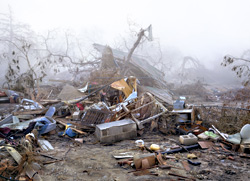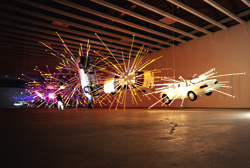Katrina-Land
A living room carpet cracked like a parched riverbed, desperate anonymous messages scrawled across fences and walls—these are the sorts of images that caught the eye of four photographers as they documented the ruins of New Orleans, possibly our nation’s biggest human and natural disaster in “Katrina-land: Photographs of the Hurricane’s Devastation.” With stunning work by Chris Jordan, Debbie Fleming Cafferty, Wyatt Gallery, and Will Steacy, the group show coincides with the hurricane’s first anniversary. The artists’ canny sense of composition, technical clarity, and their respect for their subject make this a powerful show. In one of her understated gelatin silver prints, former Louisiana resident Cafferty shows a sad simple epitaph written on the side of a house: “Dorothy Holloman Drowned August 29, 2005 He called my name.” Gallery captures quiet images like a mud-caked Cadillac or a row of forgotten and sagging library books in his series, “Remnants After the Storm.” In his “Human Stain” series, Steacy photographed other people’s family photos he found amongst the debris. Once treasured, and potentially banal, images—children in a bathtub, newlyweds—have become fascinating abstractions and studies in loss in their stained, damaged states, blurred by strange ribbons of patterns made by random exposure to unnatural elements. And local photographer Jordan, who normally focuses on piles of discarded consumer objects representing American excess, took his camera down to the Delta at the end of 2005. He, too, discovered that the devastation was in the details. His Dollar Store shows aisles awash with broken jars, slippers, candy, and toys. In Remains of a House (pictured), a home in the Ninth Ward is almost majestic in its upheaval, a cathedral of ruin under a misty sky. Like many of Jordan’s pictures, it is strangely beautiful, yet with an emotional undertow. I found the stack of broken branches in Tree Limbs eerily similar
to post–World War II photos of Nazi concentration camps showing piles of personal items—shoes, hair, teeth—wrenched from victims. The power of images to capture people’s attention has long been proved. Photos of war realities helped bring an end to the Vietnam War. They are conspicuously absent from our current war in Iraq. Katrina is no less an historic moment. What it will ultimately represent remains to be seen: the last gasp of a faltering government, the facade ripped off a racial divide, or a turning point in a young nation’s self-absorption. Like Dorothea Lange’s images of the Great Depression, these photographs offer an indelible reminder of this historic event. SUE PETERS








